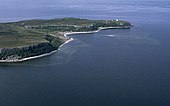Stora Karlsö
| Stora Karlsö | ||
|---|---|---|
| Stora Karlsö | ||
| Waters | Baltic Sea | |
| Geographical location | 57 ° 17 '2 " N , 17 ° 58' 25" E | |
|
|
||
| length | 4 km | |
| width | 1.8 km | |
| surface | 2.5 km² | |
| Residents | uninhabited | |
| Lilla Karlsö (left), Stora Karlsö (right), Gotland in the background | ||
Stora Karlsö ( German Large Charles Island ) is a 2.5 km² Swedish island west of Gotland , which can be reached daily from Klintehamn by boat from May to September . The island is one of Sweden's outstanding nature reserves and is owned by Karlsö Jagt- och Djurskyddsförenings AB. Stora Karlsö is designated as a Natura 2000 area. Hikes on the ornithologically and botanically interesting island are accompanied by a knowledgeable guide. Not far is the sister island Lilla Karlsö .
Stora Karlsö claims to be the second oldest protected area in the world after Yellowstone National Park in the USA: The island was placed under protection in the 1880s.
geology
Stora Förvar
Stora Förvar is a 25 m deep grotto on the north side of the island. Lars Kolmodin investigated its four-meter-thick cultural layer at the end of the 19th century. In the finds, which mainly date from around 5000 to 1500 BC. Chr., Bones of humans and animals and ceramic remains protrude. Harpoons point to fish and seals being caught . There were finds in the upper layers that indicate that the grotto was also visited during the Bronze and Iron Ages, as well as in the Middle Ages.
Lauphargi and Rösju
Lauphargi and Rösju are two of the great Rösen . They come from the Bronze Age , which lived here between 1500 and 1000 BC. Is set. The round hill about 4 m high and about 25 m measuring on the southwest side is the special shape of the crater hill, which is also present in Kauparve . The cairn grave is believed to date from the older Bronze Age (approx. 1500–1000 BC).
At the highest point of the island is "Röjsu", the somewhat larger rose covered by an ash tree, which Carl von Linné already described. In the cairn grave, which is 28 m in diameter, the ash tree that Linnaeus mentioned on his trip to Gotland still grows .
fauna
Large colonies of razorbills ( Alca torda ) and black guillemots ( Cepphus grylle ) can be found on Stora Karlsö . The guillemots breed by the thousands on the steep reefs around the island. Until the island was bought by the nature conservation society, the seabirds were hunted and the breeding populations were decimated to the point of almost extinction.
In 1983, an epidemic broke out in mountain hares ( Lepus timidus ) on the island, which was largely isolated from mammals . Investigations in the showed that the pathogens probably reached Stora Karlsö from the Finnish mainland by means of birds.
Individual evidence
- ^ Stora Karlsö. In: EUNIS. Retrieved January 25, 2012 .
- ↑ Stora Karlsö Natura 2000. (PDF; 464 kB) In: Länsstyrelsen Gotland. Retrieved January 25, 2012 (Swedish).
- ↑ Stora Karlsö nature reserve. In: Länsstyrelsen Gotland. Retrieved January 31, 2012 (Swedish).
- ↑ a b Stora Karlsö. In: Natures Best. Retrieved July 12, 2019 (American English).
- ↑ T. Mörner, G. Krogh: An endemic case of tularemia in the mountain hare (Lepus timidus) on the island of Stora Karlsö. In: Nordisk veterinaermedicin 36.9-10 (1984), pp 310-313.
literature
- E. Nylén: Gotland soil monuments.
- Grottan Stora Förvar på Stora Karlsö. Examined by Lars Kolmodin and Hjalmar Stolpe; described by Bror Schnittger and Hanna Rydh, 1940.
Web links
- Lauphargi - entry in the database "Fornsök" des Riksantikvarieämbetet (Swedish)
- Rösju - entry in the database "Fornsök" des Riksantikvarieämbetet (Swedish)
- Stora Förvar - entry in the database "Fornsök" des Riksantikvarieämbetet (Swedish)
- Information board. In: Länsstyrelsen Gotland. Retrieved January 31, 2012 (Swedish).
- Description Swedish pictures and video






